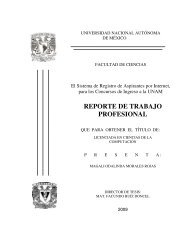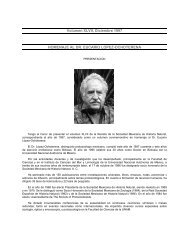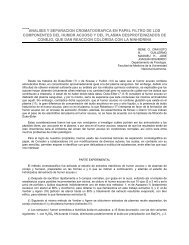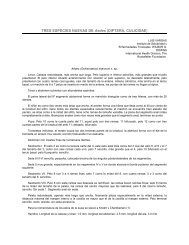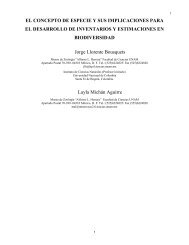Imprimiendo - Revista de la Sociedad Mexicana ... - Ciencias,UNAM
Imprimiendo - Revista de la Sociedad Mexicana ... - Ciencias,UNAM
Imprimiendo - Revista de la Sociedad Mexicana ... - Ciencias,UNAM
You also want an ePaper? Increase the reach of your titles
YUMPU automatically turns print PDFs into web optimized ePapers that Google loves.
were located at Columbia University, un<strong>de</strong>r the lea<strong>de</strong>rship of G.N. Calkins, the first (and only?) American to occupyformally a Chair of Protozoology (his title, Professor of Protozoology); at Johns Hopkins University, with diverselea<strong>de</strong>rs H.S. Jennings, R.R. Hegner, and S.O. Mast, joined eventually by M.M. Metcalf; and at the University ofCalifornia (Berkeley), un<strong>de</strong>r C.A. Kofoid (<strong>la</strong>ter joined by Kirby who, much <strong>la</strong>ter, was succee<strong>de</strong>d by Ba<strong>la</strong>muth).Soon thereafter, L.L. Woodruff, Calkins'first Ph. D. stu<strong>de</strong>nt and only 10 years his junior, established a center atYale University. Still <strong>la</strong>ter, we find strong graduate programs in protozoology at Illinois (Kudo, also Levine; and, much<strong>la</strong>ter, Corliss as Kudo's successor), Phi<strong>la</strong><strong>de</strong>lphia (University of Pennsylvania: Wenrich, than Diller; TempleUniversity: Schaeffer and Wichterman), New York University (Hall), Chicago (Taliaferro), Wisconsin (No<strong>la</strong>nd),Stanford (Taylor), Indiana (Sonnerborn and van Wagtendonk), Harvard (Cleve<strong>la</strong>nd and Cushman), Iowa (King), IowaState (Becker), North Carolina (Beers and Olive), Syracuse (Manwell), and California, Los Angeles (Jahn, Ball andFurgason), to mention the principal ones.I have not attempted to inclu<strong>de</strong> major centers of phycological, or mycological, research in America in the brieflist above although studies of protists sensu <strong>la</strong>to were beginning apace there, also. And in consi<strong>de</strong>ring textbooks,below, I have not given ones in phycology: bull will mention here that G.M. Smith's (1933, 1950) was one of the firstauthoritative books on the algae in America and is still a wi<strong>de</strong>ly respected work. Among the many fine texts avai<strong>la</strong>bletoday, let me cite but one, Bold and Wayne (1985), which has an admirably comprehensive coverage of algalstructure and reproduction and has a bibliography rich in citations to much of the important phycological literature ofthe 20th century. Here, too, allow me to insert references to the indispensable marine algal monographs by W.R.Taylor (1937, 1960, 1962: <strong>la</strong>st is a revised edition of the 1937 work) and the convenient "overview" book on all algaeby Prescott (1968).Textbooks of protozoology soon became avai<strong>la</strong>ble in English: Calkins’ (1901) was the first to appear, in any<strong>la</strong>nguage (<strong>la</strong>ter editions, 1909, 1926, 1933). A text by Kudo (1931, and fifth and <strong>la</strong>st edition, 1966) became the mostpopu<strong>la</strong>r --by trans<strong>la</strong>tions, thorough the world-- for many years. The books produced by the Britishers Minchin (1912)and, <strong>la</strong>ter, Wenyon (1926) were also appreciated by numerous biology stu<strong>de</strong>nts of English-speaking countries. Thefirst general protozoology text in Spanish, inci<strong>de</strong>ntally, was produced by E. Fernán<strong>de</strong>z Galiano (1921) in Madrid.Beltrán's (1948) book, published in Mexico, was the first in that <strong>la</strong>nguage in the area of protozoan parasites ofhumans.Jahn and Jahn's (1949: second edition, Jahn et al., 1979) highly popu<strong>la</strong>r (and inexpensive!) little book, How toknow the Protozoa, appeared next. It was followed by scho<strong>la</strong>rly text by Hall (1953), which offered the first realcompetition to Kudo's books; and it apparently stimu<strong>la</strong>ted production of a rash of sometimes excellent teachingmanuals in English in the 1960's and 1970's and beyond (all post-1950 works, therefore not appropriate for citationhere). Hall, by the way, like Pringsheim of Germany and Lwoff of France (see references on earlier pages), andfellow American colleague Hutner (see below), was a pioneer in study of the physiology of the unicellu<strong>la</strong>r protist(pigmented f<strong>la</strong>gel<strong>la</strong>tes and, <strong>la</strong>ter, the ciliate Tetrahymena), using "puree --better, anexic-- cultures of hisexperimental organisms (see Hall, 1941, and references therein). A stu<strong>de</strong>nt of C.A. Kofoid's, R.P. Hall had manygraduate stu<strong>de</strong>nts himself, his first and probably most productive being the inimitable T.L. Jahn.An early American --in fact, <strong>la</strong>rgely, midwestern American (as opposed to domination by the east- andwest-coast schools of Calkins and Kofoid)-- multiauthored production that inclu<strong>de</strong>d nearly 200 pages of text andfigures on protozoa and algae was Ward and Whipple's (1918) Fresh-Water Biology. But the single volume that lentthe greatest impetus to (further) <strong>de</strong>velopment of protozoological research in the United States was Calkins andSummers (1941), an heuristic collection of chapters (by some 20 American specialist-authorities) to which I havepaid tribute in my paper referred to above (Corliss, 1992b). Prece<strong>de</strong>d by Hegner and Andrews (1930) and eventuallyfollowed by Chan (1967- 1972), the impressive "blue bible" of Calkins and Summers nevertheless stood --andsurvives-- as a most unique publication, truly one of a kind.Citation of specific papers of all of the American workers mentioned in the preceding paragraphs is not in or<strong>de</strong>rhere. But a few of the outstanding or <strong>la</strong>ndmark works of the ol<strong>de</strong>r lea<strong>de</strong>rs --viz., Calkins, Cleve<strong>la</strong>nd, Cushman,Hegner, Jennings, Kofoid, Kudo, Mast, Metcalf, Schaeffer, Taliaferro, Taylor, Wenrich, and Woodruff-- will be helpfulin indicating the diversity of areas covered by them and <strong>de</strong>veloped still further by their stu<strong>de</strong>nts (and the stu<strong>de</strong>nts ofthose!) in the second half of the present century. Many of them also fit one of the themes of this paper, "firsts" inprotozoology, although that is not explicitly pointed out in each case below. For example, than, see Calkins (1902a,b,1919, 1930a,b; Calkins and Cull, 1907); Cleve<strong>la</strong>nd, (1949, 1956); Cushman (1928, 1948); Hegner (1927, 1938);Hegner and Taliaferro (1924); Jennings (1904, 1920, 1929, 1931); Kofoid (Kofoid and Campbell, 1929, 1939; Kofoidand MacLennan, 1930; Kofoid and Skogsberg, 1928; Kofoid and Swezy, 1919, 1921; not to mention his pre-1900single-authored works on the p<strong>la</strong>nkton of the Illinois River, culminating monographically in Kofoid, 1903, 1908; andsee Sharp, 1914, for the first account on the eventually ill-fated "neuromotor apparatus" or Cytobrain); Kudo (1920,



